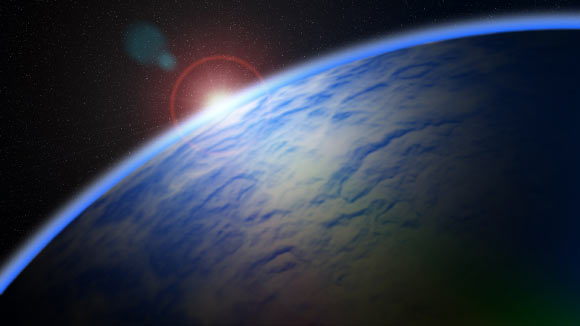Exoplanets with Hydrogen-Rich Atmospheres Could Harbor Simple Life Forms | Astrobiology, Astronomy – Sci-News.com
A team of researchers at the Massachusetts Institute of Technology (MIT) has demonstrated that single-celled microorganisms such as Escherichia coli and Saccharomyces cerevisiae that normally do not inhabit hydrogen-rich environments can survive and grow in a 100% hydrogen atmosphere.

Next-generation telescopes might look first for hydrogen-dominated exoplanet atmospheres, as hydrogen can be a viable, easily detectable biosignature of life. Image credit: Sci-News.com.
“There’s a diversity of habitable worlds out there, and we have confirmed that Earth-based life can survive in hydrogen-rich atmospheres,” said Dr. Sara Seager, a researcher in the Department of Earth, Atmospheric, and Planetary, and Sciences, the Department of Physics, and the Department of Aeronautics and Astronautics at MIT.
“We should definitely add those kinds of planets to the menu of options when thinking of life on other worlds, and actually trying to find it.”
In the early Earth, billions of years ago, the atmosphere looked quite different from the air we breathe today. The infant planet had yet to host oxygen, and was composed of a soup of gases, including carbon dioxide, methane, and a very small fraction of hydrogen.
Hydrogen gas lingered in the atmosphere for possibly billions of years, until what’s known as the Great Oxidation Event, and the gradual accumulation of oxygen.
The small amount of hydrogen that remains today is consumed by certain ancient lines of microorganisms, including methanogens — organisms that live in extreme climates such as deep below ice, or within desert soil, and gobble up hydrogen, along with carbon dioxide, to produce methane.
Scientists routinely study the activity of methanogens grown in lab conditions with 80% hydrogen. But there are very few studies that explore other microbes’ tolerance to hydrogen-rich environments.
“We wanted to demonstrate that life survives and can grow in an hydrogen atmosphere,” Dr. Seager explained.
Dr. Seager and colleagues studied the viability of two types of microbes — the bacterium Escherichia coli, a simple prokaryote, and the yeast Saccharomyces cerevisiae, a more complex eukaryote — in an environment of 100% hydrogen.
In their experiments, they separately grew cultures of yeast and Escherichia coli, then injected the cultures with the microbes into separate bottles, filled with a broth, or nutrient-rich culture that the microbes could feed off.
They then flushed out the oxygen-rich air in the bottles and filled the remaining headspace with a certain gas of interest, such as a gas of 100% hydrogen.
They then placed the bottles in an incubator, where they were gently and continuously shaken to promote mixing between the microbes and nutrients.
Every hour, they collected samples from each bottle and counted the live microbes. They continued to sample for up to 80 hours.
Their results represented a classic growth curve: at the beginning of the trial, the microbes grew quickly in number, feeding off the nutrients and populating the culture. Eventually, the number of microbes leveled off. The population, still thriving, was stable, as new microbes continued to grow, replacing those that died off.
“We do not find the results surprising. After all, hydrogen is an inert gas, and as such is not inherently toxic to organisms,” Dr. Seager said.
“It’s not like we filled the headspace with a poison. But seeing is believing, right? If no one’s ever studied them, especially eukaryotes, in a hydrogen-dominated environment, you would want to do the experiment to believe it.”
“The experiment was not designed to show whether microbes can depend on hydrogen as an energy source. Rather, the point was more to demonstrate that a 100% hydrogen atmosphere would not harm or kill certain forms of life.”
“I don’t think it occurred to astronomers that there could be life in a hydrogen environment. I hope the study will encourage cross-talk between astronomers and biologists, particularly as the search for habitable planets, and extraterrestrial life, ramps up.”
The findings were published in the journal Nature Astronomy.
_____
S. Seager et al. Laboratory studies on the viability of life in H2-dominated exoplanet atmospheres. Nat Astron, published online May 4, 2020; doi: 10.1038/s41550-020-1069-4






